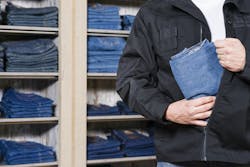Alarming rise in retail theft numbers serves notice to retailers
With the release of the 27th Annual Retail Theft Survey, conducted by Jack L. Hayes, Inc., there is one disturbing fact that should concern every loss prevention executive – the future prospects of shrink in almost every retail environment is not shrinking.
As the number of shoplifting and internal theft numbers continue to rise since 2010, and recovery dollars for shoplifting offenses and dishonest employees is up dramatically, shrink continues to grow at alarming rates. Increases in traditional shoplifting, fraud from store employees and vendors, along with administrative errors cost the retail industry $128 billon globally in 2013 -- $42 billion in the United States, according to a study underwritten by Checkpoint Systems. For Mark Doyle, president of Hayes International and a veteran of 29 years in the loss prevention field, these are staggering statistics that are even more frightening when represented by the 25 major U.S. retailers surveyed in his team’s latest research.
“After reviewing the results of our 27th Annual Retail Theft Survey, one of my conclusions is, something has to change, and soon! We keep reporting increases in shoplifter and dishonest employee apprehensions and recovery dollars year after year, but shrink is not coming down. I think education may be the key,” says Doyle, whose survey participants included all large retailers like department stores, mass merchants and Big Box stores with AP/LP staffs dedicated to the prevention of theft (internal and external).
Doyle points out that most of the larger retailers all employ technologies such as EAS, video surveillance, security packaging, lock-up devices/cases, EBR (exception based reporting) software, but most also have thorough AP/LP training and awareness programs with in-house store AP/LP staffs. He says they make apprehensions as a last resort, yet, apprehensions continue to be on the rise every year.
The numbers back Doyle’s concerns, as 1, 192,193 shoplifters were apprehended in 2014 – an increase of 7.4 percent from the prior year. As a result, almost $160 million was recovered from these shoplifters, which was a 7.5 percent rise over last year. According to the survey, this was the 12th increase in shoplifting recovery dollars in the past 13 years. For the 18th consecutive year, dollars recovered from shoplifters where no apprehension was made (over $82 million) increased. In 2014, this increase was a significant 15.2 percent. The average shoplifting case value in 2014 was $133.80, showing minimal change from 2013's average case value of $133.76.
The reasons survey participants attributed to the increased shoplifting apprehensions and recovery dollars varied. An increased focus and attention by the asset protection and loss prevention teams has certainly led to more busts on the retail floor. Yet other factors are not so proactive. Participants cited continued growth and complexity of Organized Retail Crime (ORC) activity; a stagnant economy; the opening of new stores in more metro markets; and less sales associates on the selling floor to prevent thefts.
As for the statistics tracking dishonest employees, the numbers are just as disheartening. The survey participants apprehended 80,366 dishonest employees in 2014, which was up 1.7 percent from 2013; recovered more than $66 million from these employees, an increase of 18.1 percent from a year ago, and saw the value of employee stolen good average $825.36, which was a substantial increase of 16.2% from 2013’s average case value ($710.34). Not unexpected, many of the same reasons given for external shoplifters held true for internal theft cases as well, with reduced pre-employment screening looming as the X factor.
“Both shoplifting and dishonest employee apprehensions and recovery dollars have increased the past four years. While our survey participant retailers continue to make ‘preventing the theft’ their main focus and goal, the thieves keep finding ways to circumvent our anti-theft strategies/controls, which results in a growing number of apprehensions having to be made,” says Doyle. “What's the answer? There is no simple answer, but I believe it includes continued diligence on the part of retailers and their AP/LP staffs, a team-effort approach to controlling theft, not only with departments inside the retailer, but with local law enforcement, court systems and elected officials.”
Doyle and his associates do have some straightforward advice for retailers looking to increase their odds of combating the growing scourge of thieves and bad employees. When it comes to shoplifting:
- Providing good customer service is still the best deterrent to shoplifting
Shoplifters want and need privacy; so take it away from them with good customer service. When they state they are "just looking", have associates respond with something like "Ok, but I’ll keep my eye on you in case you need any assistance”. Honest customers are ok with this (you are there if needed); while it is the last thing a shoplifter wants to hear. Also, have associates constantly walking about the sales floor and checking on customers.
- Ensure clear site lines on the sales floor to easily view customers moving about
Do not block the view of high value and highly popular items, and keep these items near employee work areas, and in clear view.
- Limit the number of items placed on the sales floor
Certain high value and highly pilferable items should just have a limited number of units on the sales floor. This will reduce your vulnerability to large losses of these items and make it easier to identify missing items.
- Invest in and use anti-shoplifting technology wisely
Anti-shoplifting technology such as EAS tags (electronic article surveillance), Ink/Fluid tags, merchandise alarms, CCTV cameras, product tie-downs, and bulky packaging can all be effective in reducing shoplifting when used effectively.
- Know your merchandise, and what's popular with thieves
Know what your highly popular items, high value items, what's stolen most often are, and what’s easily stolen. Research why items are taken, evaluate their locations and packaging – then make changes.
Doyle also offered hints on how to deter employee theft:
- Conduct a thorough pre-employment screening process on all applicants
The first step to controlling employee theft truly starts at the point-of-hire. A thorough pre-employment screening process including, reference checks, “honesty testing”, SSN trace/verification, criminal background checks, and drug testing is most important. Money spent up-front in the screening process will result in savings from reduced turnover and losses.
- Use an effective point-of-sale exception based monitoring program
An effective POS exception based monitoring program will quickly identify possible fraudulent transactions at the point of sale (i.e. excessive refunds or voids; refunds or voids before or after store hours; excessive discount usage, etc.).
- Conduct regular audits to ensure compliance with company policies and procedures
Ensure consistent compliance to company policies and procedures by conducting loss prevention/shrink audits on a regular basis. By reducing the opportunity, you reduce the chance of theft/loss.
- Invest in a loss prevention awareness and reward program for associates
Be sure all associates are given training and awareness on loss prevention issues. Also, implement a reward program for associates who report dishonest activities of other associates.
- Ensure loss prevention "basics" are in place and adhered to at all times:
- Door controls (OH doors locked and Exit doors alarmed) - no unsupervised egress
- Trash controls (monitor and supervise the removal process, and keep dumpsters locked)
- Package/bag checks (conduct bag check whenever an employee exits the location)
- POS controls (two people should witness and verify all refunds and voids)
While Doyle realizes there is no magic wand that can change the societal problems that embolden citizens to steal from retailers, he maintain that education can play an integral role in any long-term solution in combating shrink.
“Education of the public as to the severity of the theft problem, and how if negatively effects each consumer on a daily basis is crucial. Education of school aged children, as to the consequences of theft and the seriousness of the problem is a must. In addition, education of our community leaders and elected officials as to the negative impact theft has on the economy, on jobs, and on each citizen has to be emphasized,” concludes Doyle. “We need tougher laws against shoplifting, as I believe many thieves see shoplifting as a low risk and non-offensive crime which can be highly profitable while being a low-risk crime for jail time.”
For more in depth analysis of the research, go to the Hayes Inc. website at: www.hayesinternational.com or email [email protected].
About the Author:
Steve Lasky is the Editorial Director of Cygnus Security Media, as well as editor-in-chief of Security Technology Magazine and conference director for Secured Cities Houston 2015. He is a 28-year veteran of the security industry and a Quarter Century ASIS member.



